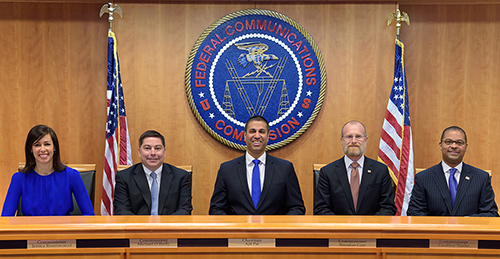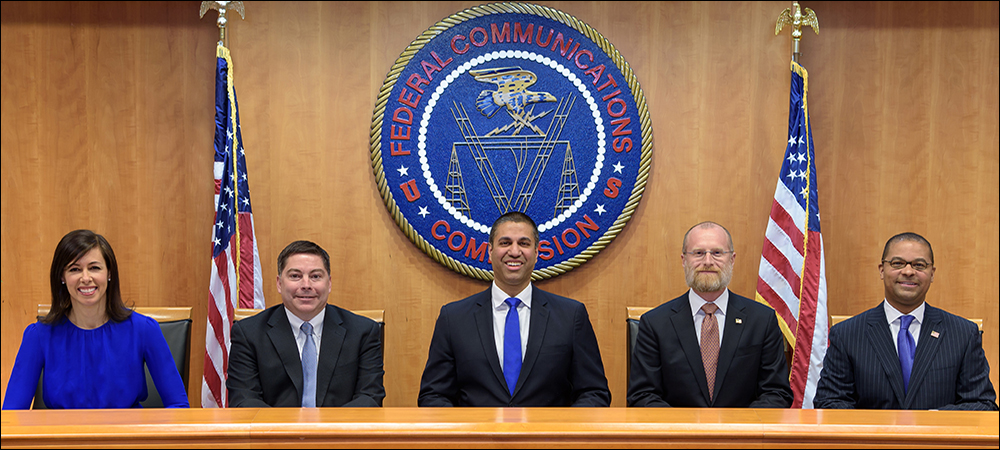An anticipated ruling by the Federal Communications Commission (FCC), which could enable Wi-Fi devices to transmit at high power in the 6 GHz band, poses some risk to ultra-wideband (UWB) technology already using the same band but at a much lower power level. Groups advocating for users of these bandwidths are requesting a meeting with the FCC to seek a compromise that they say would enable all technologies to coexist.
On Apr. 1, the FCC announced new rules for the bandwidth from 6 to 7.2 GHz, which will be opened to Wi-Fi devices. Parts of the band may be set at a relatively lower power level than suggested earlier this year, as a nod to UWB and other technology companies already using that bandwidth. However. the Apr. 1 Report & Order does not address the needs of the UWB community, argues Timothy Harrington, the UWB Alliance‘s chairman. “We are pleased that the band is being divided, but disappointed that 850 MHz will be at standard power.”

Lef to right: The FCC’s Jessica Rosenworcel, Michael O’Rielly, Chairman Ajit Pai, Brendan Carr and Geoffrey Starks
The FCC first issued an NPRM earlier this year to approve the use of unlicensed Wi-Fi devices in the bandwidth from 6 to 7.2 GHz, which would share that unlicensed spectrum with other devices already using it. However, the wide swathe of bandwidth being requested (1.2 GHz), as well as the high power being requested—up to 36 dBm—could have a negative effect on multiple systems already in use, the UWB Alliance notes.
UWB is an unlicensed VLP RFID radio communication technology covering a large portion of the radio spectrum—anything above 500 MHz. It is used in Internet of Things (IoT) applications to capture and manage sensor or real-time location data. In 2019, Apple announced that UWB technology would be built into its iOS devices, enabling smartphone to transmit and receive UWB signals. In fact, every model of the iPhone 11 has UWB built in. Applications include opening car doors, access control, “find it” applications, real-time location system (RTLS) solutions in industrial and health-care environments, and intelligent appliances.
The UWB Alliance represents manufacturers of UWB technology, with the intention of fostering growth through agnostic interoperability programs. In the case of 6 GHz allocation, the organization sees a solution in a compromise being considered in Europe. There, discussion is currently under way regarding spectrum-sharing. “There’s a good case for harmonization,” Harrington says, and the FCC could take a similar approach.
As it now stands, however, if the FCC’s commissioners and Chairman Ajit Pai make a ruling on the 6 GHz plans during the FCC’s Apr. 23 meeting, it could be the largest single allocation of high-powered unlicensed spectrum ever made. The FCC has been considering the release of 6 GHz for Wi-Fi since 2018, and the effort has support from such large technology companies as Broadcom, Intel and Qualcomm, in addition to Amazon, Facebook and Comcast.
The Wi-Fi industry is recommending (and the FCC NRPM would allow) 36 dBm as the maximum approved power allocation, which they intend to use for access points. But UWB companies argue that anything transmitting at that level of power would be 4,000 times more powerful than traditional UWB devices that utilize -41.3 dBM/NHz, Harrington says. “That will effectively drown out existing 6 GHz devices, including those UWB device used in hospitals.” The Wi-Fi industry has also proposed VLP as an alternative, but that it is still 25 times more powerful than UWB transmissions.
The UWB Alliance says the more measured approach being considered in Europe would allow the 6 to 7.2 bandwidth to be split in half, with the lower 500 GHz range (from 5.925 GHz to 6.425) set aside for Wi-Fi. If the 1.2 GHz bandwidth spectrum is not split between Wi-Fi and existing technologies, Harrington says, the UWB Alliance recommends that Wi-Fi use be limited to considerably lower power than 14 dBm, which UWB industry members argue would still enable new 6GH applications with Wi-Fi, such as artificial reality (AR) and virtual reality (VR), while allowing a high concentration of nodes.
“There’s the opportunity for harmonization there, so rules in the E.U. and the U.S. can be the same,” Harrington says. “We’re not against Wi-Fi. We know how important it is.” He argues, however, that since the spectrum is unlicensed, those that use it must meet the legal requirements for unlicensed devices that UWB product makers are already following. According to Harrington, unlicensed bandwidth users must accept interference from other devices, but must also not generate interference. “That would hold them to the requirements for unlicensed devices that they are not to interfere with us,” he says, while with the NPRM now on the table, he argues, Wi-Fi systems would do exactly that, as well as potentially interfere with other Wi-Fi transmissions.
The UWB Alliance submitted its 6 GHz sharing proposal to the FCC on Mar. 5. In the meantime, the National Association of Broadcasters (NAB) is among the groups that have licenses for use in this band that could also be impacted by the FCC’s decision, and it has reached out to the FCC about the plans. The association has requested to meet with the FCC’s Office of Engineering and Technology (OET) and the Wi-Fi leadership. They have asked OET to mediate between incumbents, both licensed and unlicensed, and the Wi-Fi industry.
If the reallocation plan is approved with high power levels, as defined in the current NPRM, a series of legal challenges will likely follow. License holders, such as TV broadcasters that use the bandwidth around 6.8 GHz, as well as utility companies also utilizing that bandwidth, could litigate the decision. Harrington predicts extended court battles, “unless some kind of agreement can be made that can allow all these stakeholders to continue to operate.”
A consortium of Wi-Fi and other high-tech companies argued, in a February 2020 letter to the FCC, that Wi-Fi needs the large swathe of spectrum to meet the demands of its growing market. “Wi-Fi has become the most important wireless technology for American consumers and businesses,” the statement said. “Opening the 6 GHz band for unlicensed use is also the fastest way to get additional spectrum suitable for next-generation wireless in the hands of American consumers.” The UWB Alliance is now awaiting the results of the FCC’s OET meeting. Harrington says he still hopes to see a compromise, adding, “Having all devices work together is really where we want to end up.”
Ultra-wideband technology is used for a variety of vertical markets that rely on the low-power transmissions to capture the information required to operate properly. That includes health care, Harrington says. In fact, he adds, UWB technology is used as part of the worldwide COVID-19 management and recovery efforts. For instance, some hospitals in China and Europe are using UWB-based “no touch” sensor chips from Novelda, a Norway-based semiconductor company. The wireless UWB systems using these chips employ UWB radar and can detect a patient’s breathing, thereby enabling health-care providers to view information without interacting directly with a patient more often than necessary.
There are also consumer goods applications. For example, the iRobot‘s Roomba can autonomously vacuum homes. The company is also developing its Terra Robot lawnmower, which will rely on UWB technology to cut lawns.
Zebra Technologies provides UWB technology to the NFL to track the movements and performance of professional football players (see Ultra-wideband Scores Contract Extension from NFL and The NFL’s Next Generation Statistics). And technology company Ubisense provides automotive and aerospace assembly solutions that serve as part of manufacturing automation leveraging UWB signals to understand the precise position of equipment and products.


